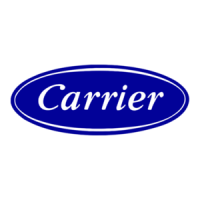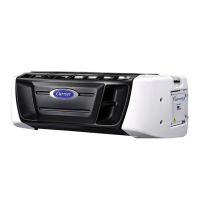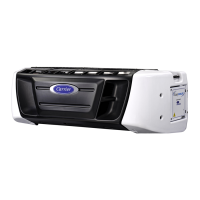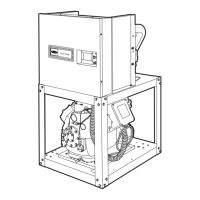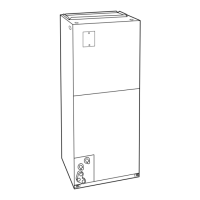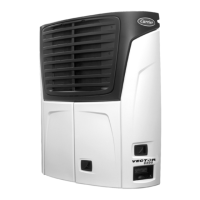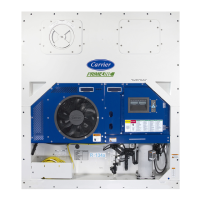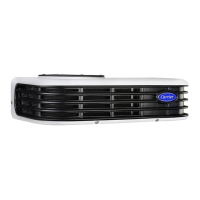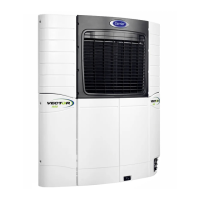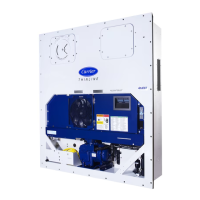3-4T-309
3.2.2 Operational Software (Function codes)
The Operational Software is t he actual operation
programming of the controller which activates or
deactivatescomponentsinaccordancewithcurrentunit
operating conditions and operator selected modes of
operation.
TheprogrammingisdividedintofunctionCodes.Some
of the codes are read only while the remaining codes
may be user configured. The value of the user
configurable codes can be assigned in accordance with
user desired mode of operation. A list of t he function
codes is provided in Table 3-5.
To access the function codes, perform the following:
a. Press the CODE SELECT key, then press an arrow
key until the left window displays the desired code
number.
b. The right window will display the value of this item
for five seconds before returning to the normal dis-
play mode.
c. If a longer time is desired, press the ENTER key to
extend the time to 30 seconds.
3.3 MODES OF OPERATION
The Operational Software responds to various inputs.
These inputs come from the temperature and pressure
sensors,thetemperaturesetpoint,thesettingsofthethe
configuration variables and the function code
assignments. The action taken by the Operational
Software will change if any one of the inputs changes.
Overall interaction of the inputs is described as a
“mode” of operation. The modes of operation include,
perishable (chill) mode and frozen mode. Descriptions
ofthecontroller interaction and modes of operationare
provided in the following sub paragraphs.
3.3.1 Temperature Control -- Perishable Mode
With configuration variable CnF26 (Heat Lockout
Temperature) set to --10_C the perishable mode of
operation is active with set points at or above --10_C
(+14_F). With the variable set to --5_C, the perishable
mode is active at or above --5_C(+23_F). Refer to
Table 3-4.
When in the perishable mode the controller maintains
the supply air temperature at set point, the SUPPLY
indicatorlightwillbeilluminatedonthedisplaymodule
and the default reading on the display window will be
the supply temperature sensor reading.
When the supply air temperature enters the in-range
temperature tolerance (as selected at function code
Cd30), the in-range light will energize.
3.3.2 Defrost Interval
Function code Cd27 may be operator set to initiate
defrostatintervalsof3, 6, 9, 12or24hours.Itmayalso
be set to OFF (no defrost). The factory default is 12
hours. (Refer to Table 3-5).
3.3.3 Failure Action
Function code Cd29 may be operator set to allow
continuedoperationi n the eventthe control sensorsare
reading out of range. Thefactory default is full system
shutdown. (Refer to Table 3-5).
3.3.4 Generator Protection
Function codes Cd31(Stagger Start, Offset Time) and
Cd32 (Current Limit) may be operator set to control
startupsequenceofmultipleunitsandoperatingcurrent
draw.Thefactorydefaultallowsondemandstarting(no
delay) of units and normal current draw. Refer to
Table 3-5.
3.3.5 Compressor High Temperature, Low Pres-
sure Protection.
The controller monitors compressor suction and
discharge temperatures and pressures. If the discharge
temperature exceeds a certain limit, theliquidinjection
valve is opened to provide sufficient liquid refrigerant
flow into the economizer line to reduce the discharge
temperature. If the liquid injection is unable to reduce
the discharge temperature sufficiently and the
temperature exceeds the allowed limit, the compressor
willcycleoff on a 3 minute timer. The compressorwill
alsocycleoffinasimilarmannerifthesuctionpressure
fallsbelowtheallowedlimit.Condenserandevaporator
fans continue to operate during the compressor off
cycle.
3.3.6 Perishable Mode -- Conventional
The unit is capable of maintaining supply air
temperatureto within ¦0.25_C(¦0.5_F) ofset point.
Supply air temperature is controlled by positioning of
the suction m odulation valve (SMV), cycling of the
compressor and cycling of the heaters.
When cooling from a temperature that i s more than
2.5_C (4.5_F)abovesetpoint, thesystemwillbe in the
perishable pull down mode. It will be in economized
operation with a target SMV position of 100% open.
However, pressure and current limit functions may
restrict the valve, if either exceeds the preset value.
Once set point is reached, the unit will transition to the
perishable steady state mode. This results in unloaded
operation with some restriction of the SMV. The S MV
will continue to close and restrict refrigerant flow until
the capacity of the unit and the load are balanced.
If the SMV is at minimum modulation, the controller
has determined that cooling is not required, or the
controllerl ogicdeterminessuctionpressureisatthelow
pressure limit, the unit will transition to the perishable
idle mode. The compressor is turned off and the
evaporator fans continue to run to circulate air
throughout the container. Iftemperature rises aboveset
point +0.2_C, the unit will transition back to the
perishable steady state mode
If the temperature drops to 0.5_C (0.9_F) below set
point, the unit will transition to the perishable heating


